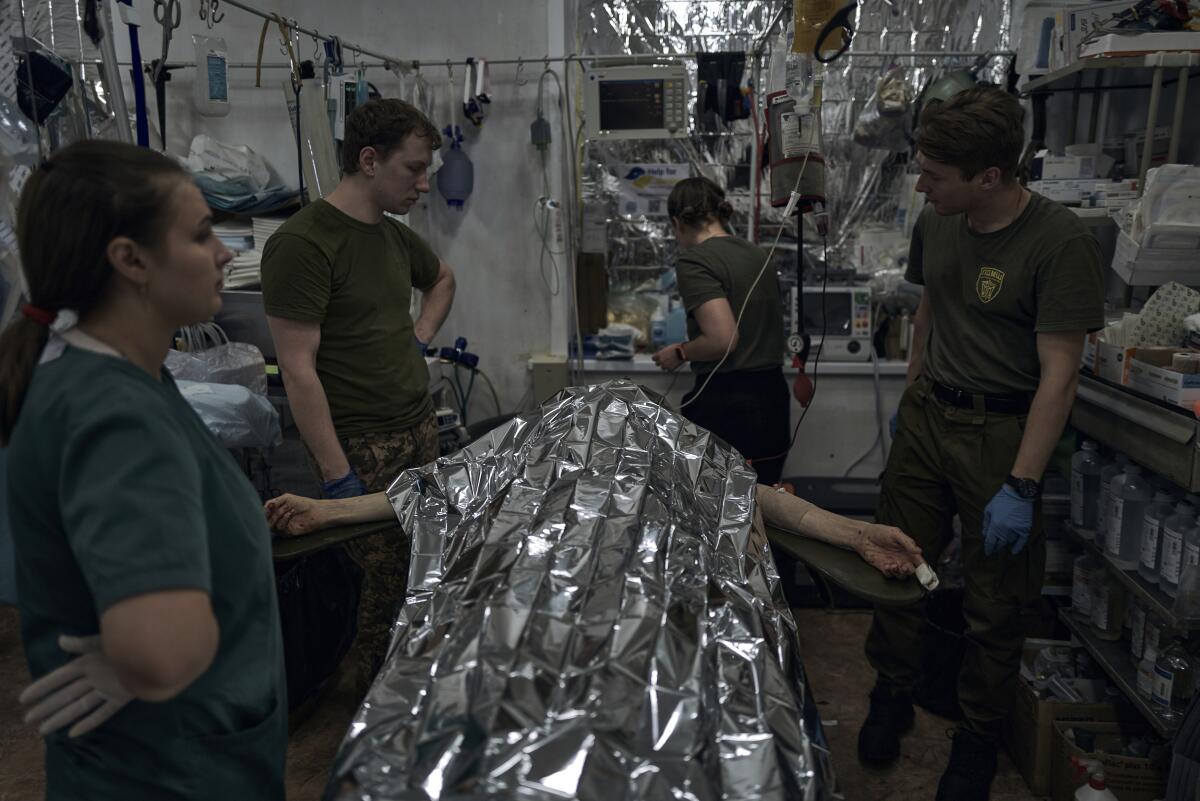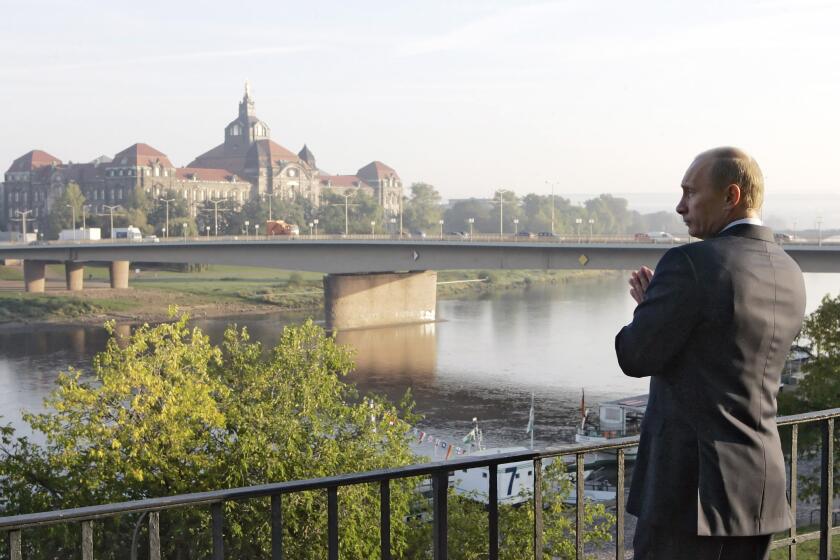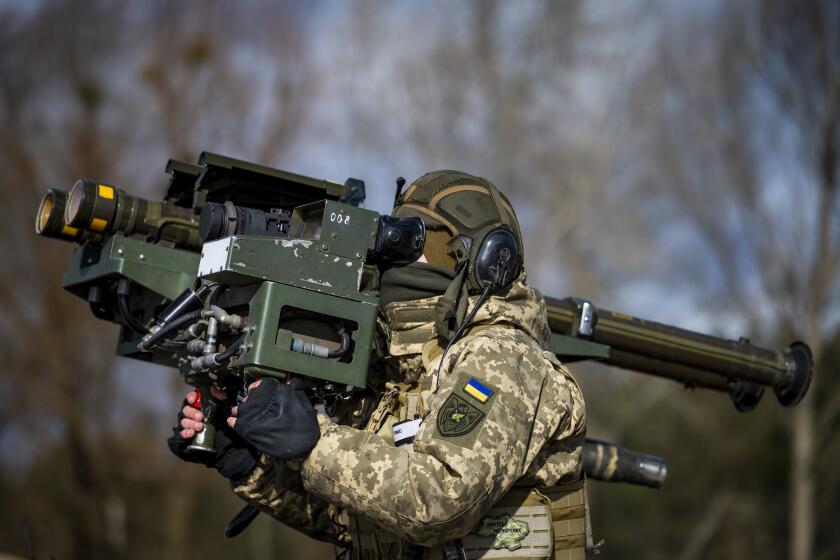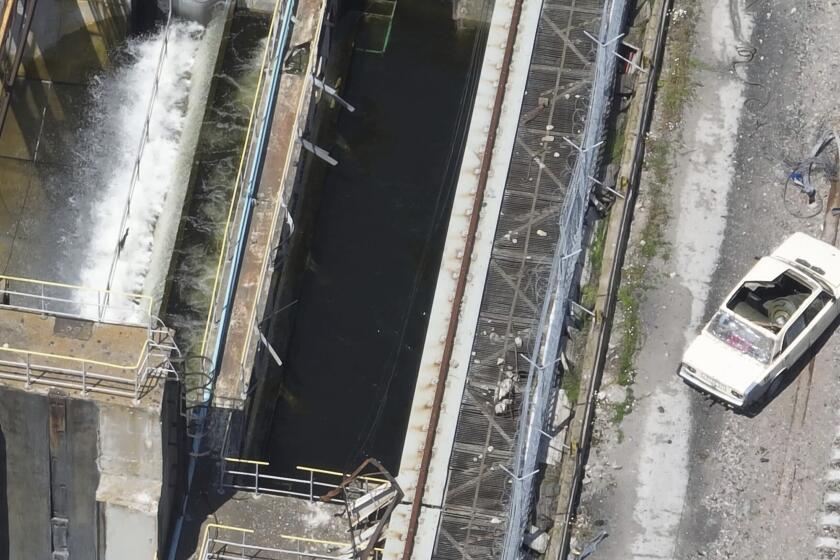Ukraine downs exploding Russian drones across the country, but some make it through

- Share via
KYIV, Ukraine — Ukrainian air defenses downed 32 of 35 Shahed exploding drones launched by Russia early Tuesday, most of them in the Kyiv region, officials said, in a bombardment that exposed gaps in the country’s air protection after almost 16 months of war.
Russian forces mostly targeted the region around the Ukrainian capital in a nighttime drone attack lasting around three hours, officials said, but air defenses in the area shot down about a dozen of them.
The attack was part of a wider bombardment of Ukrainian regions that extended as far as the Lviv region in the west of the country, near Poland.
The Iranian-made Shahed drones made it all the way to Lviv because of the inability of air defense assets to cover such a broad area, Ukrainian air force spokesman Yuriy Ihnat said.
Air-defense systems are mostly dedicated to protecting major cities, key infrastructure facilities such as nuclear power plants and the front line, he said.
“There is a general lack of air defense assets to cover a country like Ukraine,” according to Lviv Gov. Maksym Kozytskyi.
Russian President Vladimir Putin’s KGB years in East Germany offer a window into his crackdown on protests, war on Ukraine and yearning for empire.
Russia also struck Ukraine’s southern Zaporizhzhia region with ballistic missiles.
Ukraine’s air defenses have been reinforced with sophisticated weapons from Western allies, allowing the country a higher success rate recently against incoming drones and missiles.
Previously, a winter bombardment by Russia damaged Ukraine’s power supply, though speedy repairs blunted that Kremlin effort.
Attacks on infrastructure still pose a threat, but Ukraine has largely withstood Russia’s bid to plunge the country into the dark and cold of winter.
The latest aerial assaults behind Ukraine’s front line coincided with the early stages of a Ukrainian counteroffensive, as it aims to dislodge the Kremlin’s forces from territory occupied since Russia’s full-scale invasion in February 2022.
The counteroffensive has come up against heavily mined terrain and reinforced defensive fortifications, according to Valerii Zaluzhnyi, the commander in chief of Ukraine’s armed forces.
Russia has also mustered a large number of reserves, he said in a post accompanying a video of him visiting front-line positions with other senior officers.
Heavy battles are taking place in eastern Ukraine around Bakhmut, Lyman, Avdiivka and Marinka, the Ukrainian armed forces said. Russia shelled 15 cities and villages in the eastern Donetsk region, wounding five civilians, including three in Chasiv Yar, near Bakhmut, according to Ukraine’s presidential office.
Exclusive drone photos and information obtained by the Associated Press show that Russia had the means, motive and opportunity to bring down a Ukrainian dam that collapsed earlier this month while under Russian control
Ukrainian Deputy Defense Minister Hanna Maliar reported Tuesday that in the south, Ukrainian soldiers are advancing in some places but in others, “the enemy is advancing.” She cautioned against measuring progress in the counteroffensive ”solely by kilometers or the number of liberated settlements,” without stipulating what criteria would be more accurate.
Russia has relocated about 20,000 troops from the areas in the Kherson region after flooding from the June 6 Kakhovka dam collapse made it impossible for Ukraine to conduct an offensive there, Ukrainian military analyst Roman Svitan said. Ukrainian President Volodymyr Zelensky reported late Tuesday in a video address that earlier in the day, in Kherson, Russian artillery shelling killed one flood rescuer and wounded several others.
The flooding removed the need for Russian forces to protect about 180 miles of the more than 600-mile front line, according to Svitan, and allowed Moscow to increase its military density in the Zaporizhzhia and the Donetsk regions where intensive fighting is occurring.
Russia had the means, motive and opportunity to breach the dam, which is under its control, according to information obtained by the Associated Press.
Svitan said the Zaporizhzhia region appears to be the focus of the Ukrainian counteroffensive, seeking to smash through Russia’s land corridor with the Crimean peninsula, which Moscow illegally annexed from Ukraine in 2014.
News Alerts
Get breaking news, investigations, analysis and more signature journalism from the Los Angeles Times in your inbox.
You may occasionally receive promotional content from the Los Angeles Times.
In other developments, Russia’s Foreign Intelligence Service invited Ukrainian diplomats stationed abroad to come to Russia with their families to avoid returning to Ukraine. It claimed that many Ukrainian diplomats are unwilling to return home after their tours abroad and want refugee status in the European Union and Asian countries where they worked.
Also, Russian Defense Minister Sergei Shoigu alleged that Ukraine plans to use U.S.-made HIMARS and U.K.-provided Storm Shadow missiles to attack Russian territory, including Crimea. He warned that using those missiles on targets outside the current war zone would “trigger immediate strikes on the decision-making centers on the territory of Ukraine.” He didn’t elaborate and didn’t provide any evidence to support his claim, similar to his government’s earlier threats objecting to deployment of other Western weapons.
Additionally, Ukraine’s military intelligence chief, Maj. Gen. Kyrylo Budanov, announced on Ukrainian television that Russia had mined the cooling system of the Russian-occupied Zaporizhzhia nuclear power plant.
“If they blow this up, there’s a high probability we’ll suffer heavy consequences,” Budanov warned.
The plant’s six reactors are shut down but still need cooling. His claim couldn’t be confirmed.
On Tuesday, the Russian parliament’s lower house, the State Duma, approved a bill envisaging pardons for criminal convicts who join Russian forces fighting in Ukraine, a move aimed at boosting troop numbers during the first stages of Ukraine’s counteroffensive. Another bill passed by the Duma on Tuesday eases restrictions on volunteer soldiers, allowing ex-convicts to sign contracts with the military during a period of mobilization. The legislation next goes to the parliament’s upper house, then to President Vladimir Putin for expected final approval.
Even before passage of the legislation, Yevgeny Prigozhin, the millionaire owner of the Wagner Group military contractor, has been allowed to recruit criminal convicts as mercenaries, promising them pardons if they survive six months of fighting.
Budanov contradicted statements from Putin and Belarus President Alexander Lukashenko that Russian tactical nuclear weapons already have been deployed to Belarus.
“The process of preparation to their possible movement is continuing,” Budanov said on television. “The storage facilities are being prepared, but not a single warhead has been moved yet.”
Putin first said the weapons would be deployed after the storage sites for them are prepared in July, then Lukashenko declared last week that some had already been moved to Belarus. On Friday, Putin said some have been deployed as a deterrent against Western efforts to defeat Russia in Ukraine.
More to Read
Sign up for Essential California
The most important California stories and recommendations in your inbox every morning.
You may occasionally receive promotional content from the Los Angeles Times.
















